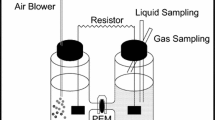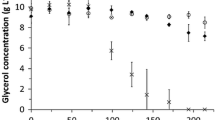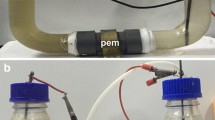Abstract
Glycerol is an attractive feedstock for bioenergy and bioconversion processes but its use in microbial fuel cells (MFCs) for electrical energy recovery has not been investigated extensively. This study compared the glycerol uptake and electricity generation of a co-culture of Shewanella oneidensis MR-1 and Klebsiella pneumonia J2B in a MFC with that of a single species inoculated counterpart. Glycerol was metabolized successfully in the co-culture MFC (MFC-J&M) with simultaneous electricity production but it was not utilized in the MR-1 only MFC (MFC-M). A current density of 10 mA/m2 was obtained while acidic byproducts (lactate and acetate) were consumed in the co-culture MFC, whereas they are accumulated in the J2B-only MFC (MFC-J). MR-1 was distributed mainly on the electrode in MFC-J&M, whereas most of the J2B was observed in the suspension in the MFC-J reactor, indicating that the co-culture of both strains provides an ecological driving force for glycerol utilization using the electrode as an electron acceptor. This suggests that a co-culture MFC can be applied to electrical energy recovery from glycerol, which was previously known as a refractory substrate in a bioelectrochemical system.





Similar content being viewed by others
References
Arasu MV, Kumar V, Ashok S, Song H, Rathnasingh C, Lee HJ, Seung D, Park S (2011) Isolation and characterization of the new Klebsiella pneumoniae J2B strain showing improved growth characteristics with reduced lipopolysaccharide formation. Biotechnol Bioprocess Eng 16:1134–1143
Ashok S, Raj SM, Ko Y, Sankaranarayanan M, Zhou S, Kumar V, Park S (2013) Effect of puuC overexpression and nitrate addition on glycerol metabolism and anaerobic 3-hydroxypropionic acid production in recombinant Klebsiella pneumoniae ΔglpKΔdhaT. Metab Eng 15:10–24
Ayoub M, Abdullah AZ (2012) Critical review on the current scenario and significance of crude glycerol resulting from biodiesel industry towards more sustainable renewable energy industry. Renew Sustain Energy Rev 16:2671–2686
Chookaew T, Prasertsan P, Ren ZJ (2014) Two-stage conversion of crude glycerol to energy using dark fermentation linked with microbial fuel cell or microbial electrolysis cell. New Biotechnol 31:179–184
Davis JB, Yarbrough HF (1962) Preliminary experiments on a microbial fuel cell. Science 137:615–616
Dharmadi Y, Murarka A, Gonzalez R (2006) Anaerobic fermentation of glycerol by Escherichia coli: a new platform for metabolic engineering. Biotechnol Bioeng 94:821–829
Dobson R, Gray V, Rumbold K (2012) Microbial utilization of crude glycerol for the production of value-added products. J Ind Microbiol Biotechnol 39:217–226
Durgapal M, Kumar V, Yang TH, Lee HJ, Seung D, Park S (2014) Production of 1, 3-propanediol from glycerol using the newly isolated Klebsiella pneumoniae J2B. Bioresour Technol 159:223–231
Flynn JM, Ross DE, Hunt KA, Bond DR, Gralnick JA (2010) Enabling unbalanced fermentations by using engineered electrode-interfaced bacteria. MBio 1:e00190–e00110
Kim JR, Beecroft NJ, Varcoe JR, Dinsdale RM, Guwy AJ, Slade RC, Thumser A, Avignone-Rossa C, Premier GC (2011) Spatiotemporal development of the bacterial community in a tubular longitudinal microbial fuel cell. Appl Environ Microbiol 90:1179–1191
Kim JR, Min B, Logan BE (2005) Evaluation of procedures to acclimate a microbial fuel cell for electricity production. Appl Microbiol Biotechnol 68:23–30
Kumar V, Ashok S, Park S (2013) Recent advances in biological production of 3-hydroxypropionic acid. Biotechnol Adv 31:945–961
Kumar V, Sankaranarayanan M, Durgapal M, Zhou S, Ko Y, Ashok S, Sarkar R, Park S (2013) Simultaneous production of 3-hydroxypropionic acid and 1, 3-propanediol from glycerol using resting cells of the lactate dehydrogenase-deficient recombinant Klebsiella pneumoniae overexpressing an aldehyde dehydrogenase. Bioresour Technol 135:555–563
Nimje VR, Chen CY, Chen CC, Chen HR, Tseng MJ, Jean JS, Chang YF (2011) Glycerol degradation in single-chamber microbial fuel cells. Bioresour Technol 102:2629–2634
Reiche A, Kirkwood KM (2012) Comparison of Escherichia coli and anaerobic consortia derived from compost as anodic biocatalysts in a glycerol-oxidizing microbial fuel cell. Bioresour Technol 123:318–323
Ren Z, Ward TE, Regan JM (2007) Electricity production from cellulose in a microbial fuel cell using a defined binary culture. Environ Sci Technol 41:4781–4786
Rodionov DA, Yang C, Li X, Rodionova IA, Wang Y, Obraztsova AY, Zagnitko OP, Overbeek R, Romine MF, Reed S (2010) Genomic encyclopedia of sugar utilization pathways in the Shewanella genus. BMC Genomics 11:494–512
Rosenbaum MA, Bar HY, Beg QK, Segrè D, Booth J, Cotta MA, Angenent LT (2011) Shewanella oneidensis in a lactate-fed pure-culture and a glucose-fed co-culture with Lactococcus lactis with an electrode as electron acceptor. Bioresour Technol 102:2623–2628
Rotaru A-E, Shrestha PM, Liu F, Ueki T, Nevin K, Summers ZM, Lovley DR (2012) Interspecies electron transfer via hydrogen and formate rather than direct electrical connections in cocultures of Pelobacter carbinolicus and Geobacter sulfurreducens. Appl Environ Microbiol 78:7645–7651
Sarma SJ, Brar SK, Sydney EB, Le Bihan Y, Buelna G, Soccol CR (2012) Microbial hydrogen production by bioconversion of crude glycerol: a review. Int J Hydrog Energy 37:6473–6490
Sengeløv G, Agersø Y, Halling-Sørensen B, Baloda SB, Andersen JS, Jensen LB (2003) Bacterial antibiotic resistance levels in Danish farmland as a result of treatment with pig manure slurry. Environ Int 28:587–595
Smith JA, Nevin KP, Lovley DR (2015) Syntrophic growth via quinone-mediated interspecies electron transfer. Front Microbiol 6:121–128
Song H-S, Ramkrishna D, Pinchuk GE, Beliaev AS, Konopka AE, Fredrickson JK (2013) Dynamic modeling of aerobic growth of Shewanella oneidensis. Predicting triauxic growth, flux distributions, and energy requirement for growth. Metab Eng 15:25–33
Wang VB, Sivakumar K, Yang L, Zhang Q, Kjelleberg S, Loo SCJ, Cao B (2015) Metabolite-enabled mutualistic interaction between Shewanella oneidensis and Escherichia coli in a co-culture using an electrode as electron acceptor. Sci Rep 5:860–863
Xia X, Cao XX, Liang P, Huang X, Yang SP, Zhao GG (2010) Electricity generation from glucose by a Klebsiella sp. in microbial fuel cells. Appl Microbiol Biotechnol 87:383–390
Yazdani SS, Gonzalez R (2007) Anaerobic fermentation of glycerol: a path to economic viability for the biofuels industry. Curr Opin Biotechnol 18:213–219
Acknowledgments
This study was supported by the Mid-career Researcher Program (2013069183) through the National Research Foundation of Korea (NRF), and by the BK21 PLUS Centre for Advanced Chemical Technology (Korea) (21A20131800002).
Author information
Authors and Affiliations
Corresponding author
Rights and permissions
About this article
Cite this article
Kim, C., Song, Y.E., Lee, C.R. et al. Glycerol-fed microbial fuel cell with a co-culture of Shewanella oneidensis MR-1 and Klebsiella pneumonae J2B. J Ind Microbiol Biotechnol 43, 1397–1403 (2016). https://doi.org/10.1007/s10295-016-1807-x
Received:
Accepted:
Published:
Issue Date:
DOI: https://doi.org/10.1007/s10295-016-1807-x




